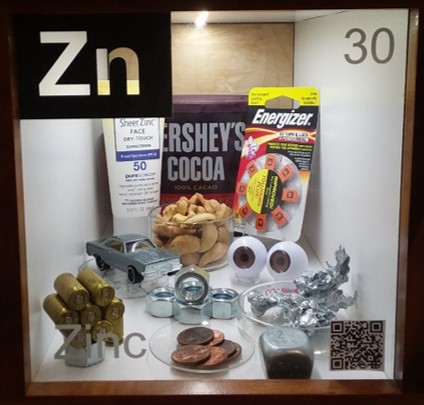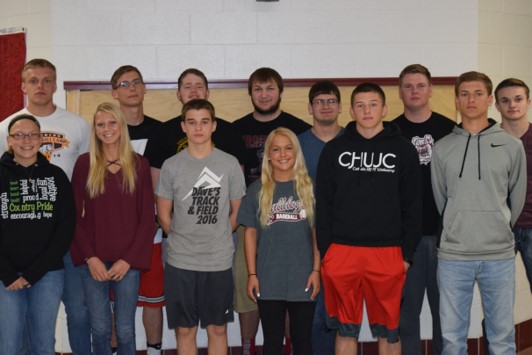Zinc

Contributor: Olivia Schaffner's Chemistry class, Edgerton High School
About the Display: This display features:
- Brass shell casings - Brass is a zinc copper alloy and contains about 30% zinc, which makes the alloy harder than pure copper.
- Cashews - In every 100 g of cashews, there are 5.78 mg of zinc. Eating a serving of cashews will give you 21% of your daily zinc value.
- Dark chocolate cocoa powder - Many foods contain zinc, including cocoa powder and dark chocolate. Cocoa powder is made up of 7% zinc.
- Fake eyeballs - The eyes have one of the highest concentrations of zinc in the body. Zinc is a "helper molecule" that brings vitamin A to the eye to form a protective coat of melanin.
- Nuts and bolts - Nuts and bolts are galvanized, or coated, with a layer of zinc to prevent corrosion.
- Pennies - Before 1982, pennies were made of 95% copper and 5% zinc but by 1982, the price of copper had become so high that the value of the metal in the coin was greater than the one cent that it was worth. In 1982, pennies began to be made of 97.5% zinc and 2.5% copper (zinc with a copper coating) and they have been made this way ever since.
- Sunscreen - The zinc in sunscreen is part of a compound called zinc oxide, which protects the skin by reflecting and absorbing UVA and UVB rays from the sun.
- Toy car - Many car parts that are made of metals are galvanized, or coated, with a layer of zinc. This prevents corrosion of these metal parts so they last longer. Also, zinc oxide is used in the vulcanization of rubber, such as that used in car tires.
- Zinc-air batteries - Like other batteries, these generate electrical power from a chemical reaction. Zinc-air batteries have tiny holes in the top, which allows oxygen molecules from the air to enter and come into contact with one of the electrodes, which is made of carbon. The other electrode consists of a zinc gel. The reaction that occurs between the two electrodes generates an electric current. The zinc-air batteries included here are used in hearing aids.
The following experiments were conducted by the contributors:
Fun Facts
- Zinc helps our immune system fight off bacteria and viruses.
- The dark meat of a chicken has more zinc than the light meat.
- Zinc is the 24th most common element in the Earth's crust (0.0075%)
- Zinc burns with a very bright blue-green flare.
- A zinc compound can take the sting out of deadly box jellyfish venom by stopping the leakage of potassium from blood cells.
- Zinc is the second most common trace metal found in our bodies.
- Every cell in the body requires zinc to multiply.
- Zinc stimulates the transport of vitamin A from the liver to the skin.
 About the Contributor: Ms. Schaffner's 4th period Chemistry class from Edgerton High School in Edgerton,
Ohio has 13 sophmores and juniors in it. Pictured in the back row, left to right,
are Drew Herman, Clayton Flegal, Cameron Jordan, Eli Branham, Micah Ritter, Zach Nihart,
and Blake Hohler. Pictured in the front row, left to right, are Leeanna Pelz, Alyssa
Siebenaler, Eric Herman, Kendra Blue, Greg Roth, and Logan Sack.
About the Contributor: Ms. Schaffner's 4th period Chemistry class from Edgerton High School in Edgerton,
Ohio has 13 sophmores and juniors in it. Pictured in the back row, left to right,
are Drew Herman, Clayton Flegal, Cameron Jordan, Eli Branham, Micah Ritter, Zach Nihart,
and Blake Hohler. Pictured in the front row, left to right, are Leeanna Pelz, Alyssa
Siebenaler, Eric Herman, Kendra Blue, Greg Roth, and Logan Sack.
Back to the Periodic Table
| <Previous element-| | |-Onward to the next element!> |
Symbol: Zn
Atomic Number: 30
Atomic Mass: 65.38 u
Electron Configuration: [Ar]4s23d10
Year Discovered: 1746
Discovered By: Andreas Marggraf


